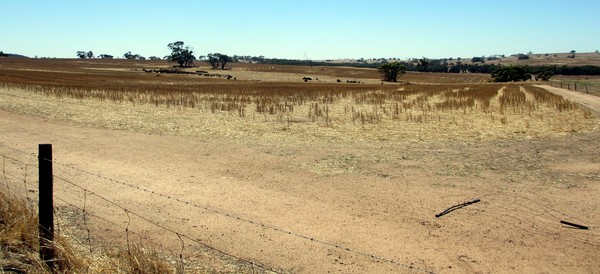The wheat belt in Western Australia is vast and not what I envisaged at all, expecting large, flat and square fields. The fields were large...but they were certainly not flat or square.
In fact the landscape was very similar to the rolling English countryside, except nearly all the trees were eucalyptus and the fields were white, either because they were stubble or droughted grassland. Many of the fields contained trees that can’t be removed without permission; if it was permissible to remove them part of a deal includes planting other trees elsewhere.
The same rules on tree removal seem to apply in other states. I stood in a 1,000-acre field in South Australia that must have contained at least 50 individual trees. This must reduce the intended efficiencies of scale, but Google Earth has resulted in greater vigilance by pressure groups. Yes, Australia also has pressure groups, in this case literally tree-huggers.
In one of my meeting’s with local farmers an unexpected issue was raised. In Western Australia there is the prospect of selling non-GM canola (oilseed rape) to Europe at a very attractive premium. However, to achieve the premium the crop has to be grown to some ‘European’ guidelines. This includes a ban on straw-burning on the farm. As I mentioned in a previous blog, burning straw is part of a strategy to control herbicide resistant rye-grass. And where the previous crop has been good, the whole stubble is burnt to enable the passage of the knife point drills.
[By the way, Australians can sell GM-free canola because, unlike the Canadians, they segregate it.]
This isn’t the first time I’ve come across European buyers expecting inappropriate crop management in Australia. A few years ago I spoke at a meeting in the Wimmera, a farming area in Victoria, and was asked a question by an incredulous farmer.
He had been contracted to grow peas by a European company and the crop management guidelines detailed that he should leave some weeds to mature in the crop. The audience fell about laughing, which grew louder when I tried to explain that in the UK it is accepted that arable weeds can contribute to biodiversity. In Australia there is so much land not in production that the pressure to encourage biodiversity on cropped land is far less than in Europe.
Mind you, there are some issues about movement of agricultural produce between Australian states. Western Australia and Victoria, and I think New South Wales, can grow GM Roundup Resistant canola. In between them is South Australia which has declared itself a ‘GM-free’ zone. This means that no GM canola seed or produce can be freighted across South Australia, even by air! I didn’t know it was that dangerous!
British farmers are not the only ones with restrictive rules and regulations. Australia is thinking of introducing downwind pesticide buffer zones for neighbouring crops and native vegetation. It’s proposed that these may be up to around 300 metres! But, surely those trees in the fields must classify as native vegetation? Let’s hope that sense will prevail.
Finally, a little tip...Australian red wines have a great reputation but the 2011 vintage is reputed to be ‘disappointing’. You heard it first here.

